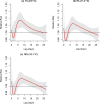The adverse effect of ambient temperature on respiratory deaths in a high population density area: the case of Malta
- PMID: 36316676
- PMCID: PMC9623984
- DOI: 10.1186/s12931-022-02218-z
The adverse effect of ambient temperature on respiratory deaths in a high population density area: the case of Malta
Abstract
Background: The effect of ambient temperature on respiratory mortality has been consistently observed throughout the world under different climate change scenarios. Countries experiencing greater inter-annual variability in winter temperatures (and may not be lowest winter temperatures) have greater excess winter mortality compared to countries with colder winters. This study investigates the association between temperature and respiratory deaths in Malta which has one of the highest population densities in the world with a climate that is very hot in summer and mild in winter.
Methods: Daily number of respiratory deaths (7679 deaths) and meteorological data (daily average temperature, daily average humidity) were obtained from January 1992 to December 2017. The hot and cold effects were estimated at different temperatures using distributed lag non-linear models (DLNM) with a Poisson distribution, controlling for time trend, relative humidity and holidays. The reference temperature (MMT) for the minimum response-exposure relationship was estimated and the harvesting effects of daily temperature (0-27 lag days) were investigated for daily respiratory mortality. Effects were also explored for different age groups, gender and time periods.
Results: Cooler temperatures (8-15 °C) were significantly related to higher respiratory mortality. At 8.9 °C (1st percentile), the overall effect of daily mean temperature was related to respiratory deaths (RR 2.24, 95%CI 1.10-4.54). These effects were also found for males (95%CI 1.06-7.77) and males across different age groups (Males Over 65 years: RR 4.85, 95%CI 2.02-11.63 vs Males between 16 and 64 years: RR 5.00, 95%CI 2.08-12.03) but not for females. Interestingly, colder temperatures were related to respiratory deaths in the earliest time period (1992-2000), however, no strong cold effect was observed for later periods (2000-2017). In contrast, no heat effect was observed during the study period and across other groups.
Conclusions: The higher risk for cold-related respiratory mortality observed in this study could be due to greater inter-annual variability in winter temperatures which needs further exploration after adjusting for potential physical and socio-demographic attributes. The study provides useful evidence for policymakers to improve local warning systems, adaptation, and intervention strategies to reduce the impact of cold temperatures.
Keywords: Ambient temperatures; Cold effect; Distributed lag nonlinear model; Respiratory mortality; Time varying effects.
© 2022. The Author(s).
Conflict of interest statement
The authors declare that they have no competing interests.
Figures





References
-
- OECD Publishing. Health at a glance: Europe 2018: state of health in the EU cycle. Organisation for Economic Co-operation and Development OECD.2018; doi: https:// doi.org/ 10.1787/ health _glance_eur-2018–9-en
MeSH terms
LinkOut - more resources
Full Text Sources
Medical

